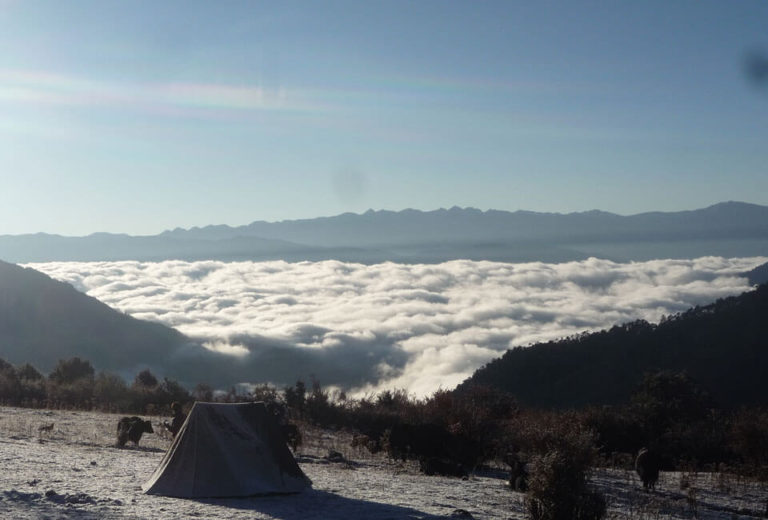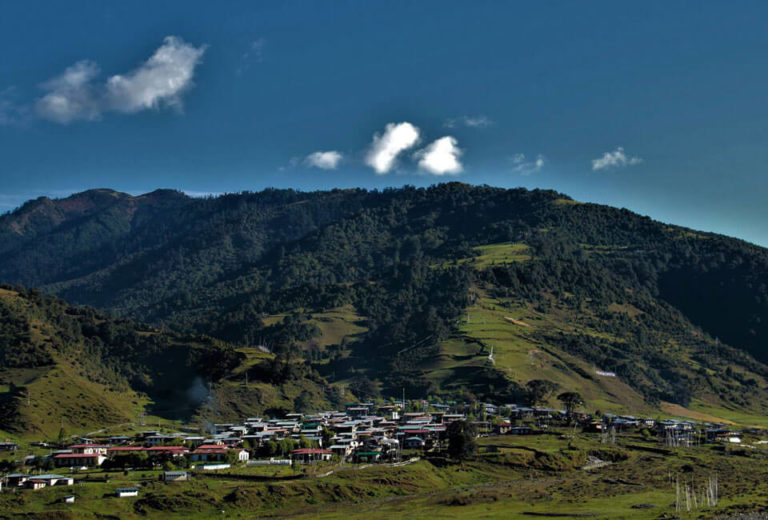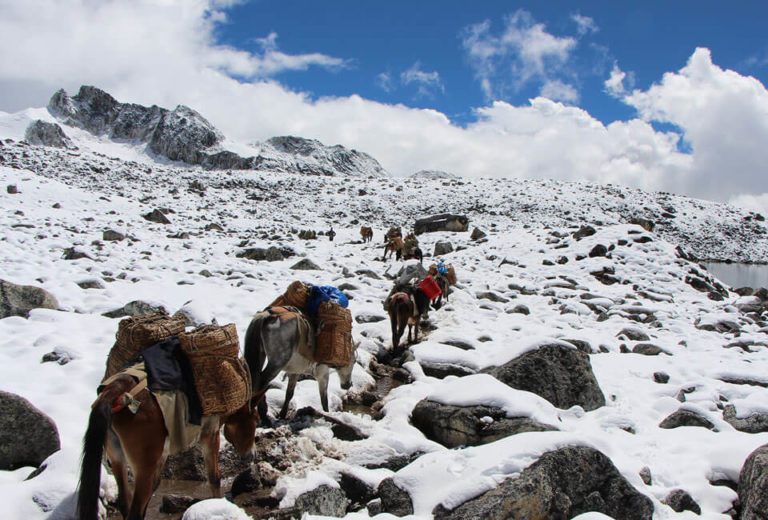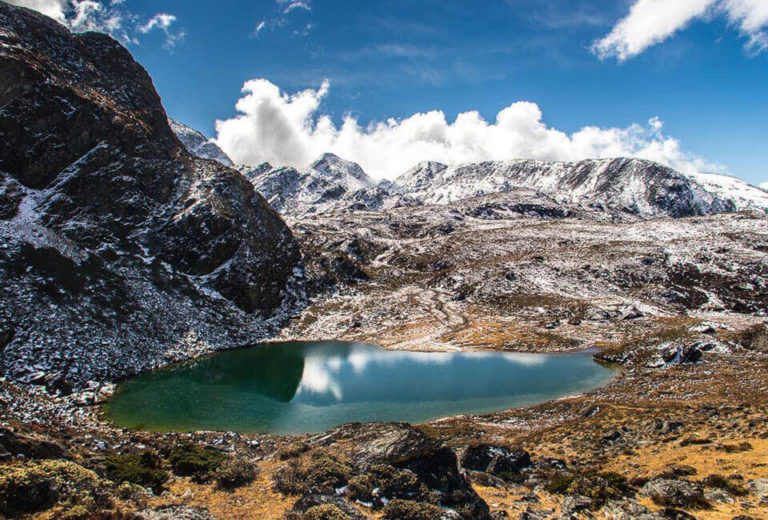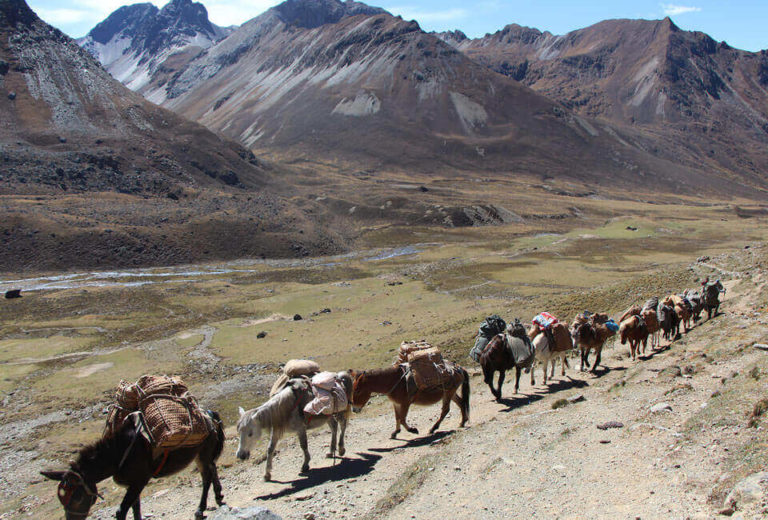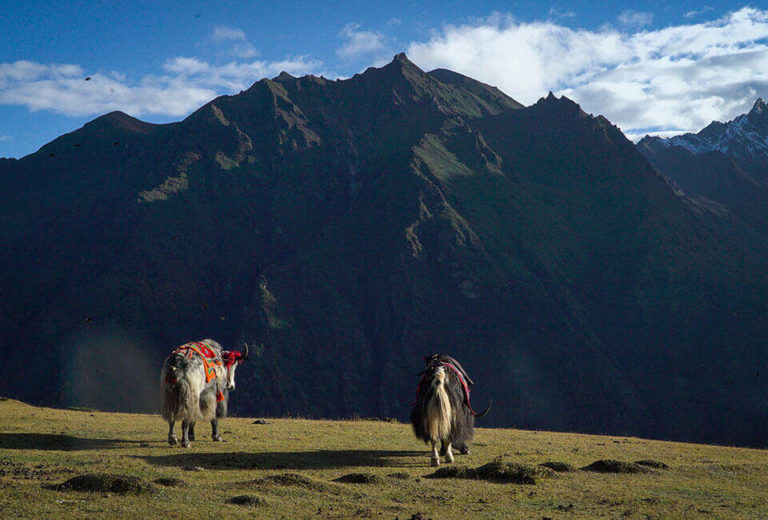Trekking in Bhutan
Overview
Trekking in Bhutan is the best way to enjoy the beautiful landscapes, flora and fauna and majestic views of Himalayan peaks. Bhutan is increasingly being touted as an example to be emulated in the fields of environment. The government is firmly committed to a policy of “The Middle Path” wherein the environment will not be scarified at the altar of development. Thus Bhutan has aptly been described as a natural paradise.Treks here present the chance to walk off the beaten path.
Trekkers are few and one can even be the very first group on a route as new ones are being developed every year. Trekking in Bhutan means walking through sylvan landscapes and pristine protected forests, against a backdrop of lofty mountains. There are also opportunities to come across rare birds, animals and plants. Depending on your physical abilities and the season you travel, there are many trekking itineraries to choose from. Each trek has its own beauty and charm.
The classic Druk Path offers spectacular views of the Himalaya as you follow the ancient high route from Paro to Thimphu.
This is the newest trek in Bhutan and it promises an unparalleled cultural and natural experience in the nomadic villages of Merak and Sakteng.
A 24-day alpine quest, which is billed as the world’s most difficult trek runs along the northern border crossing highest pass of 5320 meters.
This moderate rated trek passes by picturesque lakes so named as Thousand Lakes Trek (far fewer, however, than the name suggests).
Trekkers go to the base of Mt. Jumolhari, Bhutan’s most deeply venerated peak on the border of Bhutan and the Tibet region of China.
The Laya-Gasa Trek takes you through gorgeous alpine meadows, high mountain passes, nomadic villages and dense sub-tropical jungles before ending in Gasa.
Useful trekking information
Trekking in Bhutan definitely involves lots of preparation and logistics arrangement. The success of a trek depends on many factors like trekking equipment, personal gears, fitness and training, meals, correct information, etc. Read below what all you need to know and what you can expect from us.
Bhutan’s climate is subtropical in the south, temperate in the central and alpine in the north. The rainy season lasts from June to September. Except the Snowman Trek, you should avoid these months. The alpine zone where most of our high altitude treks run remained under snow during winter months from December to February. However, we have few beautiful low altitude treks which can be done during those winter months. The recommended seasons for trekking are Spring (March-May) and Fall (mid-September-November).
Trekking in Bhutan is fairly a different concept from other part of Himalayas. Trekking here involves camping at designated campsites as there are no teahouses or lodges on the trek routes. Here, it is a real wilderness trekking. All the food supplies and trekking equipment will be carried in by horses. You only have to carry your daypack containing personal items like camera, water bottle, toiletries, etc. The trekking entourage comprises of trekking guide, chef, helpers and caravan of horses. While your guide and one helper (to carry packed lunch) will walk with you, others will walk past you in order to make ready with tents and meals. When you arrive at camp, you will be provided with a bowl of hot water to rinse off sweat, followed by hot tea/coffee and delicious dinner.
We bet that foods on trekking will be better than what you get in cities. Our chefs are trained and experienced and can delight you with tasty foods at any settings. For breakfast, you will be served with eggs, toasts, juice, tea/coffee, sausages, hams, drinking chocolates, baked beans, peanut butter and oatmeal. Packed lunch: rice (white and red), noodles, meat, vegetables, fruits, boiled egg or potatoes and juices. Dinner: Soup as starter and then main course including rice, meat (chicken, fish, pork or beef) and vegetables. On city tour you will be provided bottled water but on trek you will be provided boiled water. You may bring purification tablets if you wish to drink stream water without boiling.
Our trekking routes will take you through dense forests, lofty mountains, spectacular high altitude lakes, meadows, streams rushing through lush valleys, remote villages and nomadic yak herders’ camps. Many of first-time trekkers to Bhutan are surprised by the unrelenting climb, which is to say mostly up, up and up, followed by down, down and down. The weather is totally unpredictable on the mountains and you may get rain or snow at any time. You should be prepared to maneuver through muddy or snowy trails and at times through moraine rocks. The average daily elevation gain is about 500m and daily walking distance will be minimum of 8 Km and maximum 12 Km, taking 4 to 9 hours. The walking distance, time and elevation vary based on your ability to walk, weather and instruments. So the figures mentioned on your itineraries cannot be taken as accurate, they are approximate.
You must be physically fit and need some training to trek in Bhutan. It is great if you have done trekking in other region prior to trekking in Bhutan. If not, do some training at home. Hike on trails having ascent and descent for 4-5 Km with 4-5 kg weight. Running, stair stepping, working on an elliptical machine, bicycling and stepmill training will also help you.
Altitude sickness Our body gets adjusted to altitude naturally and not many people get the sickness. Our well-planned itinerary usually begins with well-paced day hikes and this helps to acclimatize. To avoid altitude sickness you must wear warm clothes, drink plenty of water and walk at slower pace. You should open up to your trekking guide if you feel sick and appropriate course will be taken. Our guides are trained in handling the altitude sickness. Bring Diamox if you think you will be prone to altitude sickness. Consult your primary physician to ensure it does not interfere with any prescribed medicine you may be taking.
Separate your trekking clothes and city clothes a day before your trek. Put trekking clothes in your duffle bag to be handed over to trekking crew. Your city clothes should go into another bag (hard suitcase or even plastic bag is enough). Your driver will bring this bag to Office. We will store it in a safe locker and hand over to you on last day of the trek. Each trekker should limit the weight to 15 kg. Do not burden the horses by packing unnecessary things.
Sleeping tent
We provide state-of-the-art A-shaped tents or North Face dome tents based on season and altitudes. Tents can comfortably accommodate two persons.
Dining tent
Lunch will be served in the open air on the mountains enjoying the scenery but in camps your breakfast and dinner will be served in a spacious dining tent.
Kitchen tent
Keeping in mind the health and sanity of the trekkers, the meals will be cooked in a dedicated kitchen tent. Kitchen tents are made of waterproof nylon fabric.
Sleeping bags & liners
A weather-proof sleeping bags will be provided. However, we noticed that trekkers feel more comfortable sleeping in their own sleeping bags. If you can, bring in your own sleeping bag and it must be minimum minus 20 Degree Celsius. We provide a soft and warm inner blankets to be worn inside your sleeping bag.
Sleeping mats and pillows
Rubber mat will be placed on the ground and on top it will be air inflatable mat. Combination of two mats will give you a good night’s sleep after a tiring trek. We also provide compressible pillows.
Hot water bags
On high altitude treks, we provide hot water rubber bags to each trekker because it makes you warm at night. Also, it will be helpful if you have joints and back pain.
Toilet tent & seat
A hole will be dug and placed a foldable toilet seat over it inside the toilet tent. A hole will be leveled by trek assistants when you leave the camp the next morning.
Table & chairs
We provide foldable iron chairs and tables with tarpaulin designs.
Kit bags
We provide tarpaulin kit bags that look something like Army kit bags. Duffle bag that you are going to bring will be put inside our kit bag and carried by horses.
Packing list for the trek
TECHNICAL CLOTHING
- Down parka
- Warm fleece jacket
- Comfortable trekking boot
- Lightweight shoes
- Rain gears
- 4 pair trekking socks
- 2 long sleeve capilene shirts
- 2 capilene bottoms (mid & heavy weight)
- 2 trekking shirts (non-cotton is best!)
- Trekking pants (zip off shorts are nice)
- 1 pair shorts
- 1 bandana
- Warm gloves
- Flip flop (or similar shoes)
- Warm hat
- Sun hat
- 2 pair sunglasses
EQUIPMENT
- Small daypack
- Waterproof duffel for gear
- Warm sleeping bag (negative -20 degree celcius)
- Trekking poles
- Mud guard
- Headlamp and a normal torch
- Camera and extra batteries
- Earplugs
- 2-liter water bottles (if camelback, bring also nalgene)
- Small towel
- Various size plastic bags to keep gear dry and separate
OTHERS
- Anti bacterial hand gel for disinfecting hands
- Medical kit that includes motion sickness tablets, diamox, etc.
- Lightweight toilet articles (shampoo, soap-travel size)
- Sunscreen, lip screen and insect repellent
- Water purification tablets (iodine or chlorine)
- High calorie snacks and energy bar
- Some books to read at camps
Copyright © Bhutan Travel Guru - All Rights Reserved.


